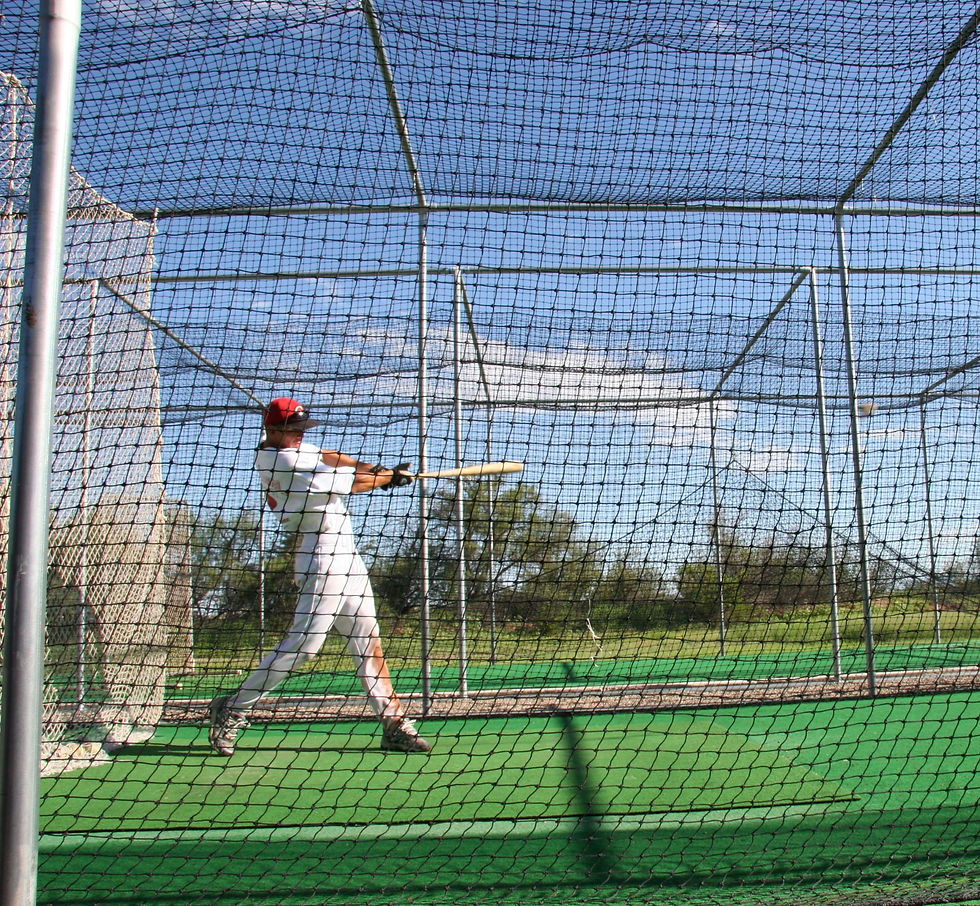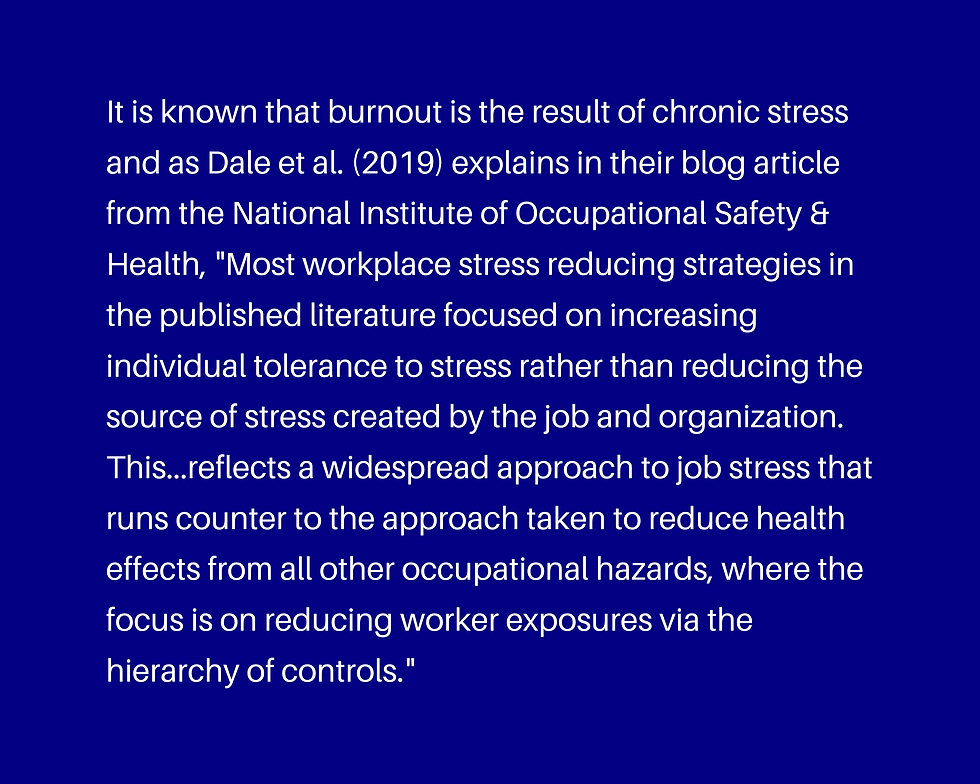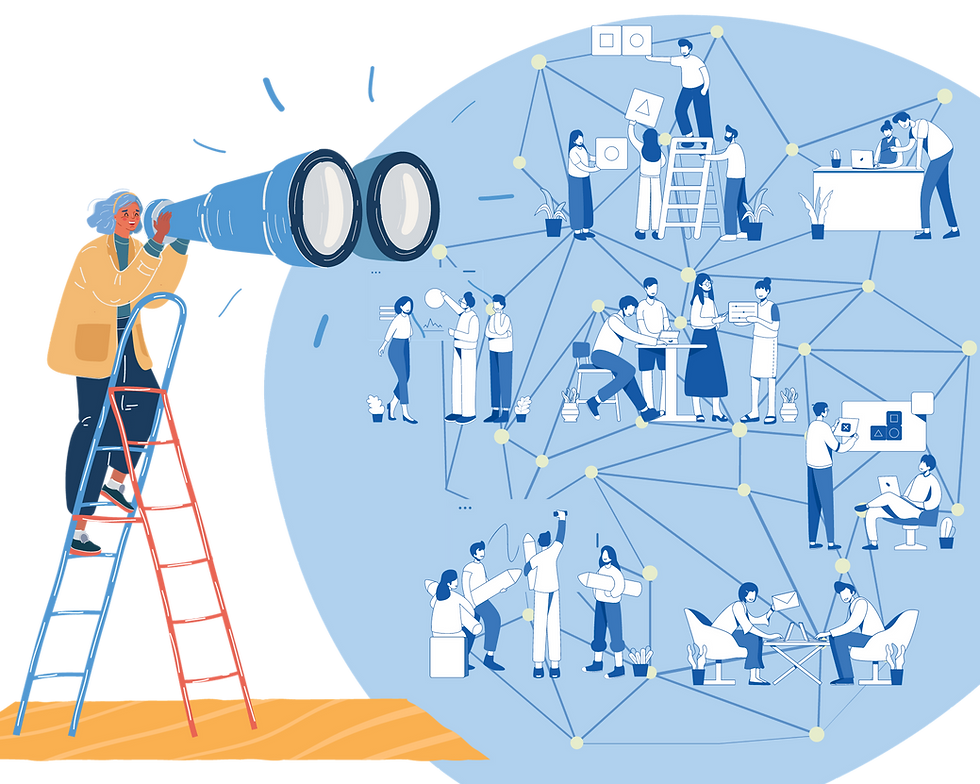Addressing Burnout, Boosting Engagement: The Power of Organizational-Level Strategies
- Tim Bower

- Dec 4, 2023
- 10 min read
Updated: Jun 26

Many of us find joy in the world of sports, whether through active participation or passionately following our favorite teams. Thinking about the players on your beloved team – can upskilling one or two individuals genuinely transform the overall success, not just of a team, but of an entire organization?
Most amelioration efforts (change strategies) are based upon the assumption that “it is the responsibility of the person, not the organization, to do something about the problem” (Maslach & Goldberg, 1998, p. 66). In other words, the person needs to change and the organization does not need to.
As a devoted Chicago Cubs fan who endured decades of subpar seasons and heartbreak, I can attest that, regardless of how much a few players or the entire team improved their skills and mindsets, my Cubbies still fell short…until the organization-level changes were made and in 2016 we ended a 108-year championship drought. Go Cubs Go.
Rethinking Change: From Personal Effort to Systemic Empowerment
Individual-level initiatives play a role in any change effort. They can promote agency and deliver short-term benefits by reshaping mindsets, skills, and behaviors. But without shifting the organizational conditions that shape how people work, their effectiveness is limited. Structural issues embedded in systems, workflows, and decision-making routines can’t be solved by developing personal resilience, attending another wellness workshop, improving emotional intelligence, or learning new communication skills. These efforts may help individuals cope, but they don’t fix the system that created the problem.

To help us put this into focus, let’s shift our attention to those individual-level interventions we are more familiar with – the ones aiming to give each employee a little boost in addressing burnout and disengagement. The leaning toward individual-centered prevention, intervention, and change is dominant in the literature and practice and “tend to parallel those for any stress-related disorder” (Farber, 2000, p. 676).
Calling for a Holistic Approach: Beyond Quick Fixes to Sustainable Change
Fix-the-person strategies may feel efficient, but they rarely move the needle on lasting change.
Despite their immediate appeal, research consistently shows that these individual-level interventions have limited long-term impact on workplace experience and organizational health (Leiter & Maslach, 2017). It’s like bringing a screwdriver to a construction site—useful in isolation, but nowhere near enough to build something substantial. If the goal is to create an empowered, engaged workforce, then we need to stop treating symptoms and start redesigning the system.
What we need is a system-level strategy that integrates both individual and organizational empowerment, where structures, expectations, and resources are aligned to support how people actually work. Real change happens when we embed empowerment into the design of the organization, not just the development of individuals.
Beyond the Individual: Four Key Advantages Explored
This article briefly highlights four compelling reasons, supported by research, emphasizing why organization-level interventions outshine their individual-level counterparts in effectively tackling the complexities of burnout and disengagement. At the end of this article, you will find guiding questions to help you take a critical look at your current strategies for change.
#1 - Inadequate Addressing of Systemic Issues
To reiterate, Most amelioration efforts to address burnout and improve engagement are based upon the assumption that “it is the responsibility of the person, not the organization, to do something about the problem” (Maslach & Goldberg, 1998, p. 66).
As Jennifer Moss (2019) explains in the HBR article Burnout Is About Your Workplace, Not Your People:
“Although developing emotional intelligence skills — like optimism, gratitude, and hope — can give people the rocket fuel they need to be successful, if an employee is dealing with burnout, we have to stop and ask ourselves why. We should never suggest that if they’d just practiced more grit or joined another yoga class or taken a mindfulness course, their burnout would have been avoided."
Focusing on individual-level interventions is like skimming the surface; you're missing the root causes buried in the organizational structure, systems, processes, and procedures. It's akin to fixing a leaky roof by repainting the ceiling—temporary and not hitting the core issues.
“Burnout is best addressed at the organizational level rather than the individual one” (Maslach and Leiter, 1997, p. 72).
Burnout and disengagement are complex issues influenced by systemic factors within the organization. The level of burnout and engagement found in individuals depends on the quality of the work environment (Schaufeli & Enzmann, 1998), and we should focus on “uncovering the characteristics of the bad situations where many good people function” (Maslach, 1978, p. 114).
In addition to providing adequate resources to employees, “[t]he main aim of an organization should be to design the job demands such that people can fulfill them without damaging their health” (Bakker et al. 2005, p. 179).

As such, interventions can be designed to bring about changes in the way the organization works. Maslach advised some 25 years ago – strategies to change the job situation into a more engaging workplace are better than those “strategies of changing the person” (Maslach, 1998, p. 81).
It is no secret and this very important prescription is echoed again and again – Changes are needed “in the ways in which the organization structures, coordinates, and manages the work of its people” in pursuit of goals (Nadler & Tushman, 1999 as cited in Osland & Turner, 2011, p. 641). By not addressing the systemic issues, organizations miss the opportunity to create a real, lasting impact and promote a healthier work environment (Maslach et al., 2001).
#2 - Sustainability Challenges
Changing individual mindsets and behaviors is important, no doubt. But here's the rub – individual-level interventions demand a constant flow of effort and resources to keep their impact alive. Picture it like watering a plant without taking care of the soil. Without corresponding changes at the organizational level, keeping the benefits rolling, if they were realized at all, becomes a real challenge.
This is not a new understanding, nearly four decades ago, Peter Brill (1984) found in his research that “interpersonal issues as the primary focus of intervention lead to regressive frustration” and that “interventions focused solely on the interpersonal are almost always doomed to fail” (p. 18).
More recently, Awa et al. (2010) found individual-centered, or person-directed, interventions were short-lived in that they only helped to reduce burnout for six months or less while the “organization-directed interventions” on the other hand had longer-lasting effects (12+ months). Demerouti & Bakker’s (2011) research also provided support that employees have a tendency to slip back into old habits that result in burnout and disengagement if the organizational environment remains unchanged.
With many resources dedicated to bringing about change, a focus on sustainability would seem of utmost importance.
🩹 Common Symptom-Focused Approaches
Mindset & Emotional Framing
Resilience and mindset training→ Adaptability, positive thinking, mental toughness
Grit, motivation, or self-discipline boosters→ “Push through,” growth mindset, personal accountability
Gratitude and positivity practices→ “Just be thankful,” appreciation rituals, journaling
Vulnerability and authenticity encouragement→ “Share openly,” “bring your whole self to work”
Wellness & Self-Care
• Mindfulness and wellness programs→ Meditation, yoga, wellness apps, breathwork
• Self-care and “fill your cup first” advice→ Rest, boundaries, balance strategies
Interpersonal Skills & Emotional Intelligence
• Emotional intelligence and empathy development→ Self-awareness, emotion regulation, perspective-taking
• Kindness, generosity, and emotional labor framing→ “Be nice,” “give more,” show up for others
• Communication and interpersonal skills workshops→ Active listening, assertiveness, team dynamics
• Conflict resolution and "difficult" conversations training→ Feedback scripts, de-escalation, mediation
Productivity & Performance
• Time management and productivity coaching→ Prioritization tools, inbox zero, energy hacks
• Coaching and mentoring for performance→ 1:1s, behavioral models, development plans
• Inspirational leadership messaging→ “Lead like a legend,” model greatness, inspire others
Here's the Problem
These strategies may help individuals cope.But they don’t change the environment that’s burning people out.
Sustainable change starts by fixing the system—not just fortifying the people stuck in it.
Imagine This...
It’s like asking someone to swim in a toxic pool.
You give them goggles, a wetsuit, and breathing techniques.
They might last longer, but you didn’t clean the water.
Eventually, the toxicity breaks through.

That’s what happens when we teach people to “cope” with burnout...
...But leave the system untouched.
Coping strategies help people survive bad systems.
#3 - Potential for Inequality
Now, let's talk inequality. Individual-level approaches are a bit like unevenly distributed snacks at a party – some get more, some get less, and maybe some get nothing. They vary in implementation and reach, leading to inconsistent experiences and potentially worsening inequalities within the organization (De Lange et al., 2008; Saks, 2006). It's like playing favorites, and that's not cool.
Flip the script, and it is evident that organization-level interventions offer a more equitable approach. By addressing systemic factors, they ensure everyone gets a fair share of the good stuff, leveling the playing field (Greenberg, 2017). I can go on and on about this…But, I am sure this focus on inequality and fairness is quite salient for many and does not need a more detailed explanation.
#4 - Lack of Organizational Support
Relying solely on individual-level interventions is a bit like that – placing the burden of change squarely on the employees. It's like saying, "Hey, you fix it," without realizing that organizations hold the strings to a supportive work environment.

Let’s go back to our favorite sports team and imagine them without a coaching staff, where each player is left to devise their own game plan. Some may excel individually, and that’s exciting to watch, but the lack of a cohesive strategy and shared direction could lead to confusion on the field. Relying solely on individual-level interventions within an organization is like expecting a team to succeed without a coaching staff. Without the organizational support and structures, the team will most likely struggle to coordinate efforts, resulting in limited effectiveness and a struggle to create long-lasting improvements (Robertson & Cooper, 2011).
Conclusion
In the quest to address employee burnout and disengagement, individual-level interventions do offer certain advantages, akin to expecting star players to carry the entire team. While they have their merits, it's not merely about upskilling individual players; it's about reshaping the entire game.
The real game-changer is building empowerment into the system, addressing the structural, procedural, and cultural factors that shape daily work. Organizational change isn’t about pushing harder on people—it’s about designing and creating conditions that let them succeed. By shifting how the organization functions, you unlock capacity at every level and create space for people to do their best work.
Ultimately, the grand slam against burnout and disengagement lies in a holistic approach. This holistic approach acknowledges that individual-level changes and organizational-level changes are not mutually exclusive but rather complementary components of a successful employee engagement and burnout reduction strategy.

A system-based empowerment approach moves beyond isolated interventions and focuses on reshaping the core design of the organization—its structures, systems, workflows, and routines. It addresses root causes, distributes responsibility more equitably, and creates the kind of healthy, empowering culture where employees thrive. When the organization is built to support people, people can build extraordinary things in return.
It's high time to break free from conventional thinking about change and wholeheartedly embrace the transformative potential of organizational-level interventions as the driver of the holistic approach…I advocate for the transformative power of team-level, small-change, those small shifts that reshape culture, elevate experience, and build a truly healthy organization.
Now that we've established the case for system-based change, it's time to Assess Your Playbook and take a critical look at your current strategies. Are your strategies focused primarily on changing individuals through skills training, coaching, or mindset work, or are they also reshaping the systems, structures, and conditions that determine whether people can thrive?
Here are a few questions to ask yourself:
This isn’t just a check-up—it’s a chance to rewire how your organization functions. Be honest, be bold, and use these questions to identify where structural empowerment can turn intent into sustained impact.
Are We Using System-Level Strategies to Address the Structural Causes of Burnout and Disengagement?
Assess whether your organization actively uses strategies at the organizational and team levels to tackle the root causes of burnout, not just the symptoms.
Are We Designing Our Approaches Around Structural Empowerment—Including Roles, Workflows, Processes, and Access?
Reflect on whether your strategies consider how the structure itself supports—or hinders—empowered performance.
Are Our Interventions Tackling Root Causes—Or Just Treating Symptoms?
Examine if your current efforts are reaching the systemic level or staying surface-level with one-off training and coping strategies.
Are Our Feedback Loops Empowering People to Speak Up and Influence the System?
Evaluate how communication and feedback mechanisms function. Do they allow employees to surface systemic barriers and shape real change?
Are We Building Capacity at All Levels—Not Just Upskilling People, But Structuring the Organization to Support Them?
Consider whether your organization is evolving both its people and its systems to unlock sustainable performance.
Can Our Systems Flex and Adapt—Or Are They Locked in Rigid, Outdated Structures?
Reflect on whether your strategies are nimble and responsive or too anchored to past practices and inflexible processes.
Are We Leveraging Small, Systemic Changes That Unlock Big Shifts in Empowerment and Performance?
Identify whether you're using targeted, low-friction changes that cascade into broader shifts across culture, clarity, and capacity.
Step into the batter’s box with a system built for empowerment—and swing for transformation. Your next-level performance starts with how you design the game.
Works Cited:
Awa, W. L., Plaumann, M., & Walter, U. (2010). Burnout prevention: A review of intervention programs. Patient education and counseling, 78(2), 184-190.
Bakker, A. B., Demerouti, E., & Euwema, M. C. (2005). Job Resources Buffer the
Impact of Job Demands on Burnout. Journal of Occupational Health Psychology, 10(2), 170–180.
Brill, P. L. (1984). The need for an operational definition of burnout. Family and Community Health, 6(4), 12–24.
Dale, A. M., Kibby, S., & Buckner-Petty, S. (2019). Exploring individual and organizational stress-reducing interventions across industries. 2019-02-05)[2020-02-10]. https://blogs. cdc. gov/niosh-science-blog/2019/02/05/stress-interventions.
De Lange, A. H., De Witte, H., & Notelaers, G. (2008). Should I stay or should I go? Examining longitudinal relations among job resources and work engagement for stayers versus movers. Work & Stress, 22(3), 201-223.
Demerouti, E., & Bakker, A. B. (2011). The job demands-resources model: Challenges for future research. SA Journal of Industrial Psychology, 37(2), 1-9.
Farber, B. A. (2000). Treatment strategies for different types of teacher burnout. Journal
of Clinical Psychology, 56(5), 675–689.
Greenberg, J. (2017). Positive organizational justice: From fair to fairer—and beyond. In Exploring positive relationships at work (pp. 159-178). Psychology Press.
Leiter, M. P., & Maslach, C. (2017). Banishing burnout: Six strategies for improving your relationship with work. John Wiley & Sons.
Maslach, C. (1978). The client role in staff burn‐out. Journal of social issues, 34(4), 111-124.
Maslach, C. (1998). A Multidimensional Theory of Burnout. In C. L. Cooper (Ed.),
Theories of Organizational Stress (pp. 68-85). Oxford, UK: Oxford University Press.
Maslach C., & Goldberg J. (1998). Prevention of burnout: new perspectives. Applied and
Preventive Psychology, 7(1), 63–74
Maslach, C., Schaufeli, W. B., & Leiter, M. P. (2001). Job burnout. Annual Review of
Psychology, 52, 397-422.
Maslach, C., Schaufeli, W. B., & Leiter, M. P. (2001). Job burnout. Annual Review of Psychology, 52(1), 397-422.
Moss, J. (2019). Burnout is about your workplace, not your people. Harvard Business Review, 1(1), 1-10.
Osland, J., & Turner, M. (2011). The organizational behavior reader. Pearson.
Robertson, I. T., & Cooper, C. L. (2011). Full engagement: The integration of employee engagement and psychological well-being. Leadership & Organization Development Journal, 32(6), 6-11.
Saks, A. M. (2006). Antecedents and consequences of employee engagement. Journal of Managerial Psychology, 21(7), 600-619.
Schaufeli, W. B. & Enzmann, D. (1998). The burnout companion to study and practice:
A critical analysis. London: Taylor & Francis.
Tim Bower is an Empowerment Architect and creator of the 7-HTL Empowerment Framework. He equips coaches, mentors, and people developers with the tools, strategies, and systems needed to build empowered leaders and organizations. Tim leads B Optimal’s work on embedding structural empowerment into leadership development, turning insight into real-world change.
Follow Tim on LinkedIn



Comments